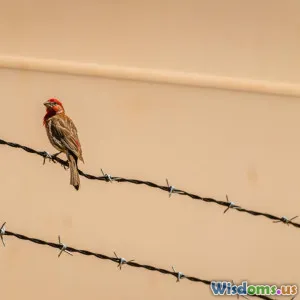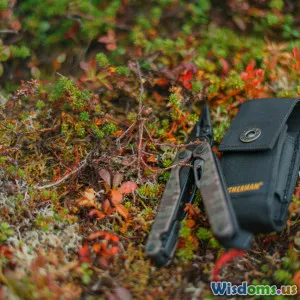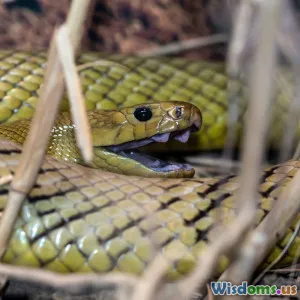
Wild Animal Attacks Rising Are You Prepared to Survive
10 min read Explore the rising threat of wild animal attacks and learn essential strategies to survive and stay safe in the wilderness. (0 Reviews)
Wild Animal Attacks Rising: Are You Prepared to Survive?
Introduction
Imagine hiking through a serene forest trail, the sounds of birds chirping, leaves crunching beneath your boots. Suddenly, a rustle nearby and—before you can process—you're face-to-face with a formidable wild animal. While such encounters have long been part of human history, the frequency and intensity of wild animal attacks are increasing globally. Climate change, urban sprawl, and habitat loss are driving wildlife closer to human populations, setting the stage for confrontations that can endanger lives.
Wild animals, from bears and mountain lions in North America to elephants and leopards in Africa and Asia, pose unique survival challenges. Understanding the reasons behind this upward trend and equipping yourself with practical knowledge could mean the difference between a fateful encounter and a well-managed situation.
This article will take you through the driving forces behind rising animal attacks, identify high-risk scenarios, and arm you with survival strategies drawn from real-world examples and expert insights.
Understanding the Rise in Wild Animal Attacks
Factors Fueling the Increase
- Habitat Encroachment and Urban Expansion
As human populations grow, cities and agricultural lands expand into wild habitats. According to the World Wildlife Fund (WWF), over 75% of Earth's land surface is significantly altered by human activities. This reduces the natural territories of animals, pushing them to forage closer to human settlements. Documented case: In California, mountain lion attacks near urban edges have risen as development spreads into mountainous regions.
- Climate Change Impacting Animal Behavior
Warmer temperatures and changing ecosystems are shifting migration patterns and food sources. For example, bears might wander further during leaner food conditions, increasing human encounters. A report by the National Park Service highlights increasing bear-related incidents in Yellowstone due to prolonged drought affecting berry crops.
- Increased Outdoor Recreation and Adventure Activities
More people are exploring wilderness areas for recreation, hiking, camping, and hunting. The International Association of Outdoor Recreation reported a 20% increase in outdoor participation over the past decade, naturally elevating exposure to wildlife.
- Urban Wildlife Adaptation
Species like coyotes, raccoons, and wild boars are adapting to urban environments. Their comfort in cities leads to more frequent aggressive encounters, especially when they become habituated to human food.
Statistical Insights
- The U.S. saw a 30% increase in reported bear attacks from 2005–2020, largely near expanding suburban-rural interfaces.
- African countries recorded a rise in elephant-related injuries as agricultural lands overlap with migratory corridors.
- According to the Global Wildlife Conservation, fatal tiger attacks in South Asia have risen by roughly 15% in the past five years.
High-Risk Scenarios and Animals to Watch For
Predators Most Likely to Attack
- Bears (Black, Brown, Polar): Generally avoid humans but may attack when surprised or protecting cubs.
- Big Cats (Mountain Lions, Tigers, Leopards): Stealthy predators; attacks often occur when people are alone or jogging.
- Wild Boars: Highly aggressive, especially when cornered or protecting piglets.
- Elephants: Typically peaceful but can become violent during musth (mating season) or when threatened.
- Snakes: Venomous species like cobras and vipers can cause fatal bites if stepped on or threatened.
Common Situations Leading to Attacks
- Getting too close to wildlife for photography or curiosity.
- Surprising an animal suddenly (e.g., around dense foliage).
- Camping near animal feeding grounds or trails.
- Leaving food unsecured, attracting animals to campsites.
Example: The 2017 fatal mountain lion attack on a jogger in California stemmed partly from the athlete running alone in a region with known cougar activity and limited visibility.
Essential Survival Strategies During Animal Encounters
Preparation Is Key
- Research Local Wildlife: Before your expedition, learn about the animals in the area, their behavior, and peak activity times.
- Carry Appropriate Safety Gear: Bear spray, noise makers, and first aid kits save lives. Bear spray, in particular, has been shown to deter up to 92% of bear charge incidents.
- Travel in Groups: Animals tend to avoid groups; solo travelers especially are at higher risk.
Behavioral Tactics in an Encounter
- Stay Calm and Don’t Run: Sudden movements can trigger predatory instincts.
- Make Yourself Large: Raise your arms or use jackets to appear intimidating.
- Back Away Slowly: Never turn your back to the animal.
- Use Loud Noises: Shout, bang objects, or use air horns.
- Know Specific Animal Responses:
- For bears: If attacked by a grizzly, play dead by lying flat on your stomach.
- For black bears: Fight back using physical force.
Quote from Bear Safety Expert Brandon Hauge: "Knowing how to respond is often more about mental readiness than physical," emphasizing calmness coupled with informed action.
Post-Attack Procedures
- Seek Immediate Medical Help: Even minor wounds may become life-threatening due to infection.
- Report the Incident: Notify local wildlife authorities to prevent further harm.
- Reflect on the Encounter: Consider how it could have been avoided and apply lessons for next time.
Training and Education to Improve Safety
Community Programs and Workshops
Organizations like the National Wildlife Federation and local park services offer workshops on safe wildlife interactions.
Example: The "Be Bear Aware" program in Alberta, Canada, successfully reduced bear-human conflict by educating residents and tourists.
Technology Aids
- Apps for Wildlife Alerts: Apps like "WildSafeBC" offer real-time alerts about animal sightings.
- GPS Tracking Devices: Allow rescue teams to locate you faster in emergencies.
- Wearable Devices: Certain alarms or repellents can be mounted on backpacks for instant protection.
Real-World Stories That Teach Us
Case Study: Yellowstone Bear Attack 2021
A hiker was mauled by a black bear after leaving the designated trail to photograph wildlife. The hiker survived due to immediate application of bear spray and rapid evacuation. This incident highlighted the importance of staying on designated paths and carrying deterrents.
African Elephant Conflict
In Kenya, farmers coexist perilously close to migratory elephant paths. Community-led initiatives involving early warning systems and cultivating unpalatable "buffer crops" have minimized attacks and crop damage.
These stories serve as both warnings and blueprints for coexistence and survival.
Conclusion
The rising tide of wild animal attacks is a wake-up call to all nature enthusiasts and nearby residents. While the wilderness beckons with beauty and adventure, it demands respect and preparedness. By understanding the causative factors, anticipating high-risk scenarios, equipping yourself with the right knowledge and tools, and adopting proactive behaviors, you significantly enhance your odds of survival.
Remember, coexistence rather than confrontation is the goal. Protect ecosystems to reduce conflict, stay informed, and always be ready to respond calmly but decisively when an animal encounter occurs. Your survival depends on the blend of awareness, respect for wildlife, and preparedness.
Embark on your next adventure armed with knowledge — because in the wild, preparedness isn’t just smart, it’s lifesaving.
References
- World Wildlife Fund Habitat Reports
- National Park Service Bear Safety Data
- International Association of Outdoor Recreation Statistics
- "Be Bear Aware" Program, Alberta, Canada
- Global Wildlife Conservation Tiger Tracking
- Expert interviews: Brandon Hauge, Bear Safety Specialist
Rate the Post
User Reviews
Popular Posts

















